~ Japanese Mountains ~
■ Location of Japan
Japan is an island country in eastern Asia, consisting of four large islands: Hokkaido, Honshu, Shikoku and Kyushu. It has a land area similar to that of Germany, Vietnam and Paraguay.
It is a mountainous country rich in nature, with 75% of its land area covered by mountains. It has a long and narrow shape, with climatic differences between the north and south. Most of the mountains in the eastern part of the country snow in winter, requiring snow gear for mountaineering.

■ Japan’s Four Seasons
Japan is characterized by four distinct seasons, and each of the four seasons offers different activities in the mountains.
In spring, as the snow melts, cherry blossoms and rape blossoms begin to bloom in the Satoyama area, and the mountains are filled with the gentle green of new foliage. This is also the time of year for harvesting fresh wild vegetables, which can be enjoyed as tempura and other tasty dishes.
* Satoyama means woodland close to the village.
In the alpine areas, the severe cold weather eases off and visitors can enjoy backcountry skiing and snowshoeing in the lingering snow. The beautiful gradation of colors created by the blue sky, white snow, and fresh greenery is also a sight to behold.
Summer marks the high season for mountaineering in Hokkaido and Tohoku region, as well as the alpine peaks of the Japanese Alps and Mt. Fuji. Although the lower elevations experience hot and humid days, the high mountains above 3,000 meters offer a cool summer retreat with temperatures below 20 degrees Celsius.
Another characteristic of Japan’s mountains is that visitors can enjoy both forested areas and rocky ridges that are beyond the forest limit at the same time. Alpine flora also bloom profusely, seemingly reveling in the fleeting summer.
Another unique aspect of Japan’s summer is its rich mountaineering culture, featuring activities like canyoning and stream climbing.
In autumn, the mountains turn red and yellow with autumn leaves, offering colorful hiking experiences. In the high mountains, the first light flakes of snow begin to fall, while the Satoyama areas yield harvests of chestnuts, persimmons, apples, and other fruits, as well as mushrooms, in the fall. One-pot meals brimming with mushrooms come highly recommended during this season.
Japan is among the world’s regions with the heaviest snowfall in winter; particularly in the Joetsu area, where snow can accumulate to more than 1 meter in a single day.
While alpine areas become completely enveloped in snow, accessible only to those with advanced snowmobiling skills, snow hiking and backcountry skiing with snowshoes are enjoyable activities in the Satoyama areas.
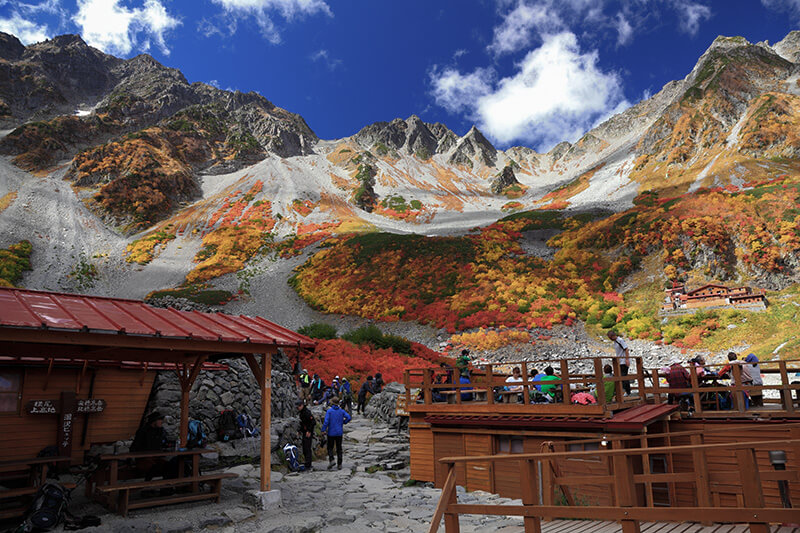
■ Climate in Japan
Each of the four seasons has its own unique climate, influenced by prevailing westerly winds from the west.
Spring and autumn have similar weather conditions, with alternating migratory high- and low-pressure systems. Sunny skies prevail under high-pressure systems, while inclement weather accompanies low-pressure systems. In addition, the weather becomes unstable during the rainy season in June. In Japan, the rainy season is called Tsuyu. In autumn, a rain front often lingers over the Pacific Ocean along the southern coast of Honshu.
When the rainy season ends in July, the summer mountain season is in full swing. As long as there are no typhoons, the weather is generally clear and the temperature remains high, but thunderstorms frequently occur in the afternoon, so caution is advised.
In winter, the Sea of Japan side and the Pacific side have different weather conditions. High pressure systems west of Honshu and low pressure systems east of Hokkaido result in snowfall on the Sea of Japan side and dry, sunny days on the Pacific side. When the low pressure passes over the south coast of Honshu, snow even falls in the mountains on the Pacific side.

■ Japan is a volcanic country
It is estimated that there are about 1,500 active volcanoes worldwide, and Japan, being a volcanic country, is home to more than 110 active volcanoes, making up just under 10% of all the world’s volcanoes. Examples include Mt. Fuji, Mt. Asama, Tateyama, and Sakurajima.
These volcanoes also explain the abundance of hot springs in Japan, contributing to a unique hot spring culture. Many trailheads are located near hot springs, so after descending the mountain, consider stopping by. There, you will find relief from your fatigue. The mineral composition and therapeutic properties of the hot springs vary from region to region, making it fascinating to explore a variety of hot springs.

■ Gourmet Food in Japan
Japan is renowned for its delicious cuisine. Restaurants and lodging facilities at the foot of the mountains offer a variety of local dishes featuring wild vegetables, mushrooms, and other mountain delicacies. Many of these dishes are exclusive to their specific regions, making them a must-try.
Additionally, since Japan is surrounded by the sea, coastal restaurants offer menus abundant in fresh seafood, showcasing a wide variety of fish.

■ World Heritage Mountains
Four mountains or mountain ranges in Japan have been registered as World Heritage sites: Mt. Fuji, the Shirakami Mountains in Tohoku, the Kii Mountains in Kansai, and Yakushima Island in Kyushu. The Shirakami Mountains and Yakushima are registered as natural heritage sites, whereas Mt. Fuji and the Kii Mountains are recognized as cultural heritage sites.
An essential element of their cultural heritage status is the religious significance; the Kii Mountains are heavily influenced by Shugendo, and Mt. Fuji by the Fuji-ko religious practices.
Shugendo, a form of mountain asceticism, plays a significant role in the Kii Mountains’ cultural heritage. Established around 1,400 years ago during the Asuka period, Shugendo blends elements of Buddhism and Taoism with traditional Japanese mountain worship. Its followers strive for enlightenment through rigorous ascetic practices in the mountains. Key centers for these ascetic practices included mountainous areas in the Kii Mountains, such as Yoshino, Omine, Kumano, and Koyasan. The Kumano Kodo, pilgrimage routes connecting these sacred sites and various other areas, are also registered as part of the World Heritage.
The Santiago de Compostela Pilgrimage Route, a pilgrimage route which connects France and Spain, is registered as a World Heritage site. Along with the pilgrimage routes in the Kii Mountain Range, it is one of the only two routes globally recognized as World Heritage sites specifically for their significance as roads.
Additionally, Fuji-ko, which surged in popularity during the latter half of the Edo period, is essentially a folk religion. It advocates for gaining divine blessings through the act of climbing Mt. Fuji. In certain aspects, it overlaps with the practices of Shugendo. Today, most people who hike Mt. Fuji do so for leisure, aiming to reach the summit. However, it is still possible to encounter believers of Fuji-ko donning traditional white robes.

■ Introduction by Mountain Range
For your convenience, the mountain areas of Japan are divided and outlined in the following map. Given that Japan is a mountainous country, numerous mountains exist beyond these outlined areas. For more detailed information about each area and mountain, please consult a guide specializing in that region.A list of IML-certified guides can be found here.
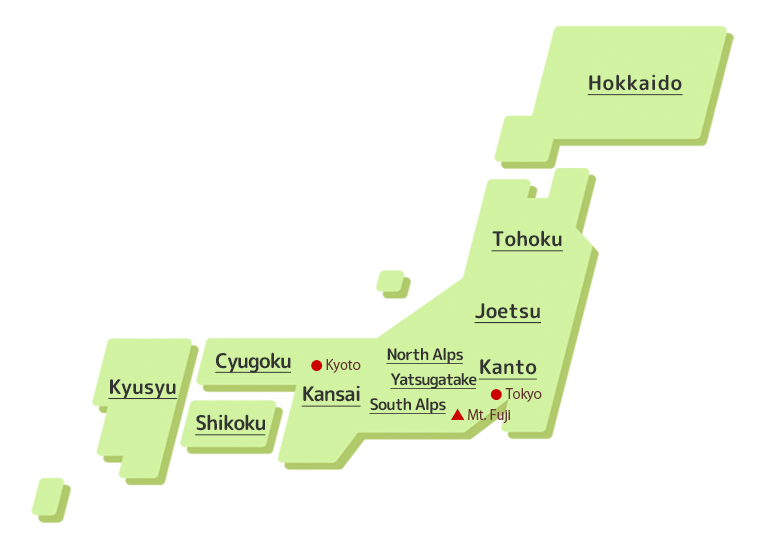
HOKKAIDO
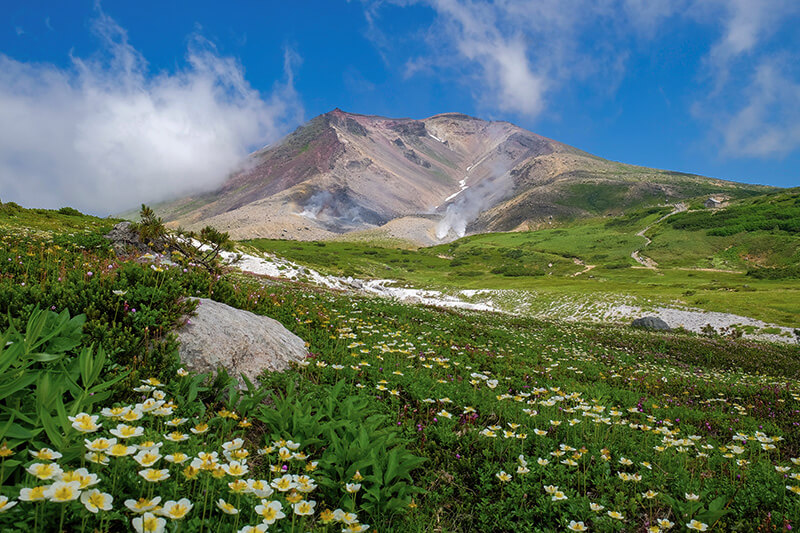
Hokkaido is the northernmost area in Japan. Because of this, temperatures are lower than those in the mountains of Honshu, making low mountain hikes comfortable even in summer. On the other hand, the first snowfall occurs early, typically by the end of September in the high mountains, resulting in a very short summer mountain season followed swiftly by the snow season.
Snow activities such as skiing and snowshoeing are popular, with the powdery snow around Niseko gaining world renown. The vegetation differs from that in Honshu, showcasing unique alpine plants. This area is unique in Japan for sightings of brown bears, warranting caution.
Famous Mountains:Mt. Rishiri, Mt. Rebun, Mt. Rausu, Mt. Tomuraushisan, Mt. Tokachi, Mt. Taisetsu, Mt. Yotei, Mt. Hokkaido-Komagatake
TOHOKU

Compared to mountains in other areas of Japan, the mountains of the Tohoku region are characterized by fewer people and quieter mountain hiking. The area has many deep mountain ranges, including the World Heritage Site of Mt. Shirakami, as well as Mt. Hakkouda, Hachimantai, and the Iide mountain range. Mountains such as Mt. Iwaki, Mt. Iwate, Mt. Bandai, Mt. Chokai, Mt. Hayachine, and Mt. Yakeishi are celebrated for their unique alpine flora.
Although the snowfall is not as early as in Hokkaido, it starts in the northern part of Honshu, typically around October. Snowshoe hikes on Mt. Zao and Mt. Nishi-Azuma come highly recommended for viewing the snow-covered ice formations known as ‘snow monsters.’
Famous Mountains:Mt. Iwate, Mt. Shirakami, Mt. Hakkoda, Mt. Bandai, Mt. Chokai, Mt. Iwaki, Mt. Hiuchi, Mt. Nasu
JOETSU
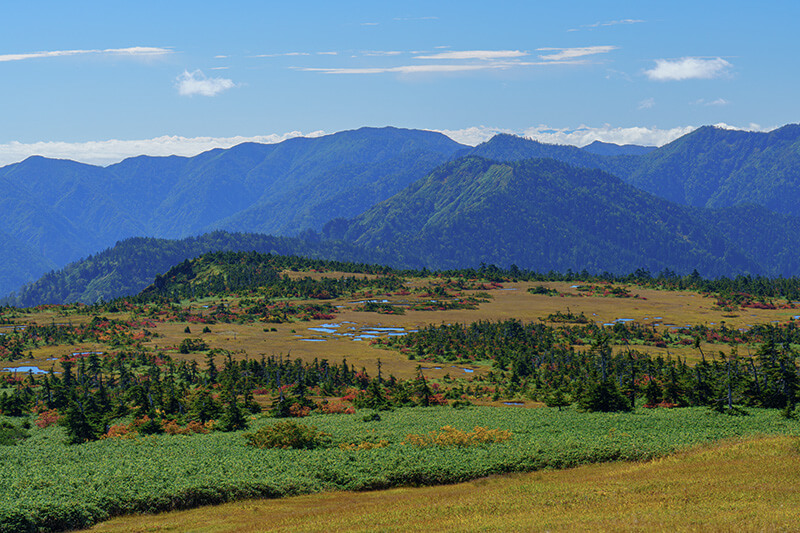
The Joetsu area, located on the Sea of Japan side, is known for its heavy snowfall in winter, with snow accumulation reaching several meters in many mountainous areas.
Few mountains in this area reach high elevations, with the highest peak, Mt. Myoko, standing at 2,454 meters. Notable mountains include Mt. Naeba and Mt. Myoko, as well as the summit marshlands in Shiga Kogen, Mt. Myogi with its unusual rock formations, and Mt. Hakkai and Togakushi, known for their rocky ridge belts. Mt. Hiuchidake is also notable, a place outside of the Japan Alps where thunderbirds are said to be seen. This abundance of snow provides the perfect conditions for visitors to enjoy skiing and snowshoeing.
Famous Mountains:Mt. Tanigawa, Mt. Naeba, Mt. Hiuchi, Mt. Myoko, Mt. Azumaya, Mt. Hakkai, Mt. Myogi, Shigakogen, Mt. Makihata, Mt. Togakushi
KANTO

Several mountain ranges surround the Tokyo metropolitan area, including the Nikko mountain range, Okumusashi, Okutama, Okuchichibu, Tanzawa, Hakone, the Misaka massif, and Izu.
Although some mountains in Nikko and Okuchichibu exceed 2,000 meters, the region primarily features lower mountains around 1,000 meters in elevation. Most can be reached on a day trip from Tokyo, making them popular among hikers. Notably, Mt. Takao (599 meters), located within Tokyo, is the most climbed mountain in the world, attracting several thousand hikers daily. Because the mountains around the Kanto area are in close proximity to Mt. Fuji, many hikers also climb these peaks for views of Mt. Fuji.
Famous Mountains:Mt. Takao, Mt. Nantai, Mt. Tsukuba, Mt. Kintoki, Mt. Tanzawa, Mt. Mitake, Mt. Kumotori, Mt. Mizugaki, Mt. Amagi
NORTHERN ALPS
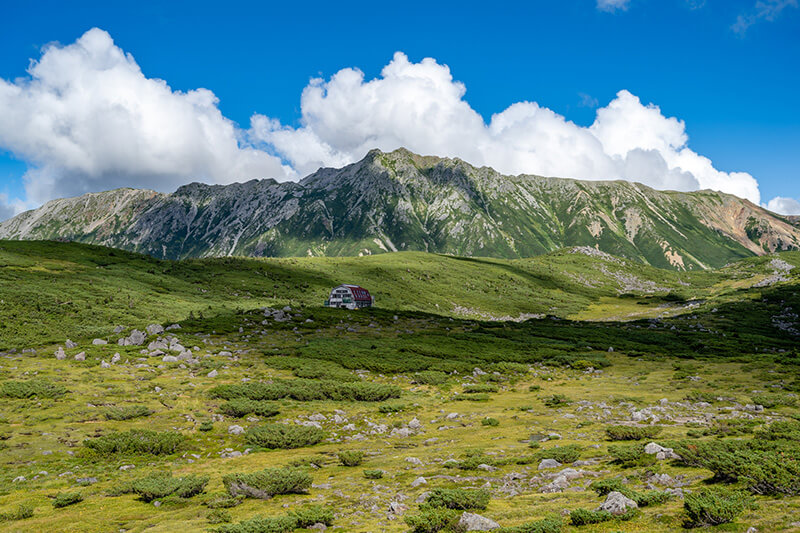
The Northern Alps rank as Japan’s most popular mountain range. Of the 21 peaks in Japan that exceed 3,000 meters, 10 are located in the Northern Alps, excluding Mt. Fuji.
Despite its elongated, vertical formation, the range boasts many visually stunning peaks, including Mt. Shirouma, Mt. Kashima-Yari, Mt. Tsurugi, Mt. Tsubakuro, Mt. Yari, Mt. Hotaka.
With numerous well-maintained mountain lodges available, traversing from one lodge to another over several days comes highly recommended. The central area, characterized by its depth and long approaches, features marshlands among other landscapes, offering a serene mountain experience.
Famous Mountains:Mt. Shirouma, Mt. Kashima-Yari, Tateyama, Mt. Tsurugi, Mt. Tsubakuro, Mt. Yari, Mt. Hodaka, Kumonodaira, Mt. Kasa, Mt. Yakedake
YATSUGATAKE
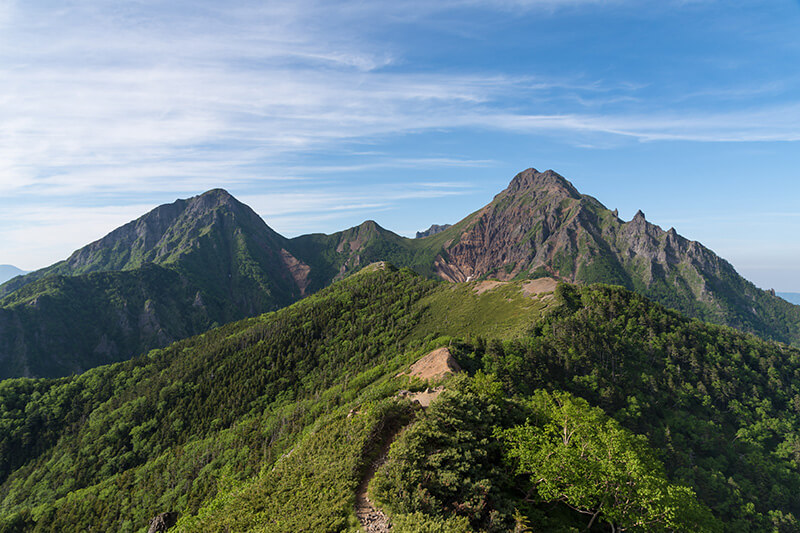
Yatsugatake is a mountain massif between the Northern and Southern Alps, with its highest peak at 2,889 m. Its popularity stems from its proximity to the Tokyo metropolitan area and the ease of experiencing an Alpine atmosphere.
The northern and southern parts of Yatsugatake present contrasting landscapes. The northern part features a virgin coniferous forest. The northern area, a veritable treasure trove of moss, boasts around 500 different types and offers a spectacular moss forest experience.
On the other hand, the southern part of range features many alpine-like mountains with rocky peaks, necessitating skill to navigate the rocky ridges. The huts are well-maintained, and the food menu at each hut offers an enjoyable experience.
Famous Mountains:Mt. Akadake, Mt. Amida, Mt. Yokodake, Mt. Iou, Mt. Tateshina, Mt. Gongen, Mt. Kitayoko, Mt. Shimagare
SOUTHERN ALPS

The Southern Alps, characterized by their massive size in comparison to the Northern Alps, has 9 peaks over 3,000 meters. The highest among these is Mt. Kitadake, standing at 3,193 meters, making it the second-highest peak in Japan. The most popular peaks are Mt. Kaikoma, Mt. Senjo, Shiramine Sanzan, and Houou Sanzan in the north, which are easily accessible and have well-equipped mountain lodges, while in the south, the peaks are more spread out and demand a higher level of physical fitness, resulting in fewer hikers and a more tranquil climbing experience. In contrast to the Northern Alps, the forest limit in the Southern Alps is higher, with a dense forest zone extending almost to the summit.
Famous Mountains:Mt. Kaikoma, Mt. Senjo, Mt. Kitadake, Mt. Noutori, Houousanzan, Mt. Shiomi, Arakawasanzan, Mt. Akaishi, Mt. Hijiri, Mt. Tekari
Mt. FUJI
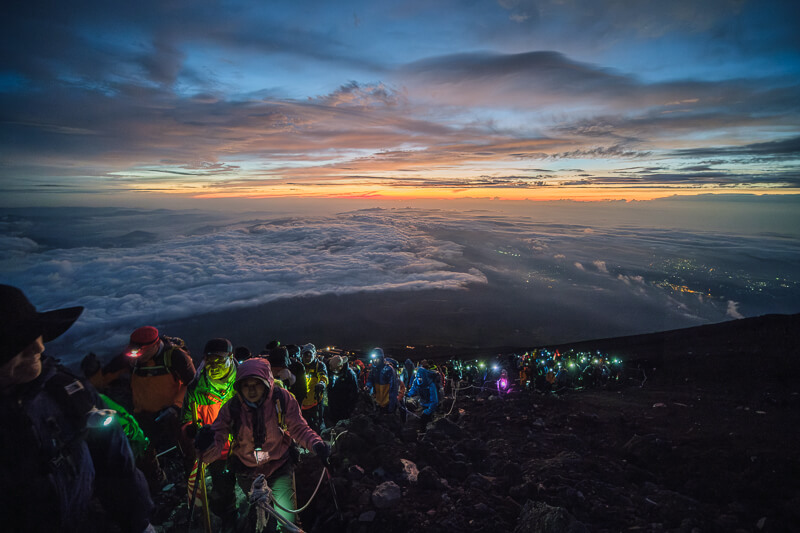
Mt. Fuji is Japan’s highest peak, standing at 3,776 meters. It is a beautifully symmetrical cone-shaped volcano, and is a symbolic mountain of Japan.
Mt. Fuji is a beloved destination for hikers, with the summer climbing season running from July 1 to September 10, attracting around 200,000 hikers annually. Due to its altitude, it is the only mountain in Japan that requires proper measures to prevent altitude sickness.
While it is recognized as a World Cultural Heritage site, the designation does not apply to Mt. Fuji alone but encompasses 25 related features, including surrounding lakes, mountain trails, and religious sites at the summit.
KANSAI

The Kansai area has numerous mountains, including the Omine and Kumano mountains on the Kii Peninsula—designated as World Heritage sites—the Suzuka Mountains east of Lake Biwa, the Hira Mountains to the west, the mountains surrounding Kyoto, and the Rokko Mountains, though these are not as high as others.
As most of the mountains are accessible for day trips, many visitors enjoy taking a hike them as an extension of their walks, making the area a popular relaxation spot for locals.
In addition, many of the mountains around the Kii Peninsula and Kyoto have long been sites for religious ascents, such as those practiced in Shugendo. It is common to encounter historically significant shrines and temples throughout these mountains.
Famous Mountains:Mt. Omine, Mt. Hakkyogatake, Mt. Fujiwara, Mt. Gozaisyo, Mt. Rokko, Mt. Buna, Mt. Koya, Mt. Hiei
CYUGOKU
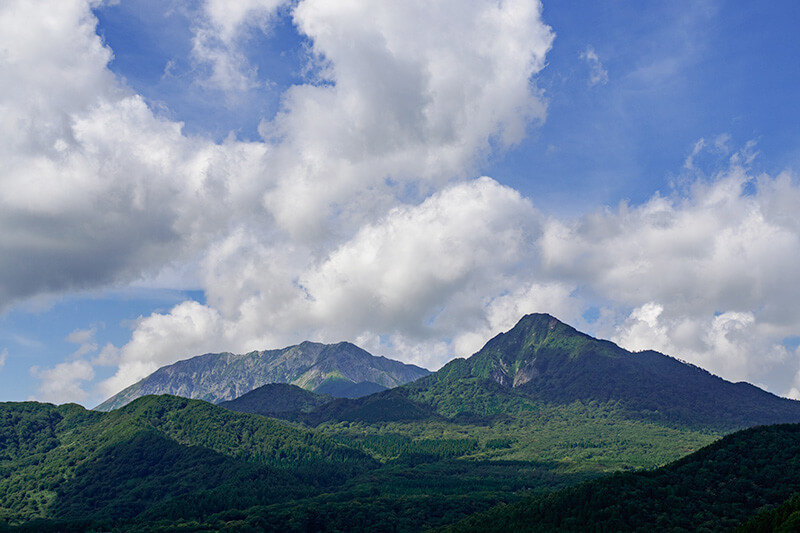
The Cyugoku region does not have any outstandingly high mountains, with the highest peak, Mt. Daisen, reaching 1,729 meters. Most of the mountains in this area, primarily situated in the Cyugoku Mountains range, average around 1,300 meters in elevation and span east to west across the Chugoku region.
The region’s mountains are generally gentle and open, providing expansive views. The climate varies significantly between the north, facing the Sea of Japan, and the south, along the Seto Inland Sea. Mountains on the Sea of Japan side experience snow in winter, whereas those on the Seto Inland Sea side enjoy a milder climate, providing a warm environment for winter mountain hiking.
Famous Mountains:Mt. Daisen, Mt. Hyounosen, Mt. Hiruzen, Mt. Sanbe, Mt. Mikura
SHIKOKU
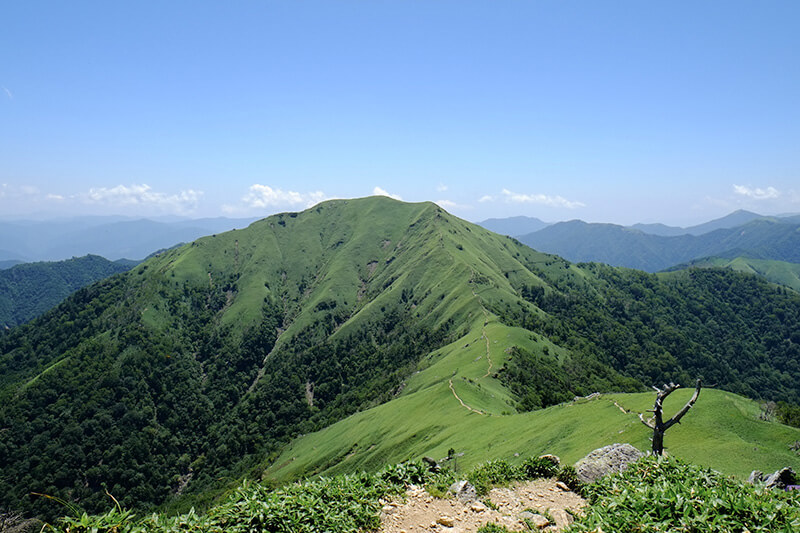
The Shikoku Mountains, running east to west through Shikoku’s center, dominate the region. The highest peak, Mt. Ishizuchi, reaches 1,982 meters. Despite Shikoku’s generally mild climate, the Shikoku Mountains are covered with snow in winter.
The region is known for the famous 88 pilgrimage sites, resulting in numerous temples within the mountains and several peaks where the practice of Shugendo flourishes.
Additionally, the Sanuki region in Kagawa Prefecture features several cone-shaped mountains known as ‘Omusubi Yama’ dotting the plains, offering intriguing landscapes.
Famous Mountains:Mt. Ishizuchi, Mt. Tsurugi, Mt. Kamegamori, Mt. Sanrei, Mt. Sasagamine
KYUSYU

Kyushu, known as the ‘Land of Fire‘, is a volcanic area with 19 active volcanoes. Renowned volcanoes such as Mt. Aso, Mt. Unzen, Mt. Yufu, Mt. Kuju, the Takachiho mountain range, and Sakurajima are located in this area.
Sakurajima is particularly active, erupting more than 200 times a year, which averages out to about once every two days. In addition, Mt. Aso’s caldera is the largest in the world, offering hikers magnificent scenery that amazes all who visit. A distinctive feature of Kyushu’s mountains is their coverage with deep forests, a testament to the region’s mild climate.
Yakushima Island, a World Heritage site, is predominantly mountainous and renowned for its heavy rainfall, which is often humorously said to rain ’35 days a month.’ This climate supports thick forests and high marshes reminiscent of tropical regions. Kyushu’s highest peak, Mt. Miyanoura, standing at 1,936 meters, is located on Yakushima.
Famous Mountains:Mt. Kuju, Mt. Hugen, Mt. Yufu, Mt. Aso, Kirishima-Renzan, Mt. Sobo, Mt. Kaimon, Mt. Miyanoura

